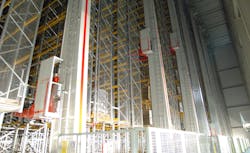Thriving in the Cold: Automated Storage Efficiency
The demand for cold chain storage continues to grow. According to Grand View Research, the North American market for cold chain storage, driven by improvements in packaging and processing as well as shifts in the retail landscape, is expected to more than double between 2019 and 2025.
This growth is occurring within an uncertain labor market. Warehouses, in general, are struggling to attract and retain talent. In 2018, industrial real estate firm CBRE analyzed the warehouse and fulfillment labor market and concluded that the industry would have to add an additional 452,000 workers in 2018-19 — more than double the industry’s actual average job growth since 2013 of 180,300 new positions per year. It’s not unreasonable to conclude that this situation will be worse in cold storage facilities where working conditions can be harsh.
Cold storage facilities are also under more pressure to manage energy costs than other types of warehouses. Energy is the number two expense in the cold chain warehouse, behind only labor.
Finally, the nature of cold chain storage is changing as well. Long-term storage, once dominant, now represents a fraction of total warehouse income in many facilities. Today’s cold chain facilities must accommodate higher-turn velocity inventory. Automation is playing a key role in addressing the labor, efficiency, and throughput requirements of cold storage facilities. However, unlike other facilities where flexible automation systems can be adapted to virtually any environment, achieving the true benefits of automation in a cold chain warehouse requires tight integration between the building design and automation system.
This paper describes a collaborative approach to cold storage facility development in which the building designer, automation vendor, and operator work collaboratively to ensure the resulting facility can meet the demands of today’s market in the most efficient way possible.
